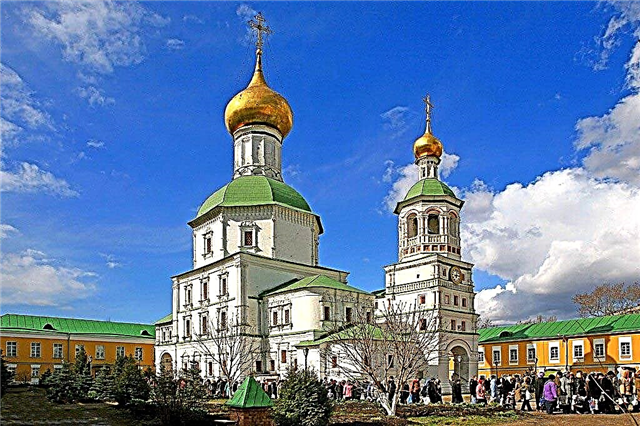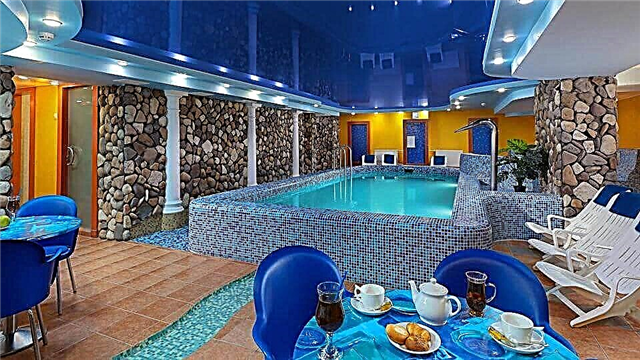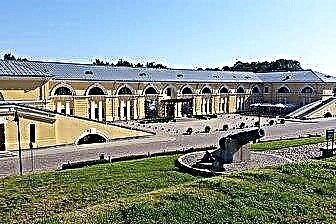Address: Russia, Moscow, Shosseinaya street
First mention: 1623 year
Main attractions: Cathedral of the Iberian Icon of the Mother of God, Cathedral of Nicholas the Wonderworker, Gate Church of the Tolga Icon of the Mother of God
Coordinates: 55 ° 40'09.6 "N 37 ° 43'09.2" E
Content:
The picturesque monastery, located 11 km southeast of the Moscow Kremlin, stands out against the background of typical buildings. The monastery, built in the neo-Byzantine and pseudo-Russian style, is considered a real gem of the Pechatniki district of Moscow.

General view of the monastery
The history of the monastery
According to legend, the Orthodox monastery was founded during the Battle of Kulikovo. It was located several miles from the city and was famous for its silence and solitude. On the high left bank of the Moskva River, there was an excellent view of the domes of Moscow churches standing in the distance.
The first evidence of the Perervinsky monastery dates back to 1623. Records about the small wooden church of St. Nicholas and the hegumen and two elders living with it have been preserved in an old palace document.
By the 50-60s of the 17th century, Russia had recovered from the difficult consequences of the Time of Troubles, therefore, stone temples began to be erected in the Nikolo-Perervinskaya monastery, as in other monasteries in Moscow. The monastery reached its greatest prosperity at the end of the 17th century, when Patriarch Adrian decided to use it as a summer residence.
In the 1770s, a seminary was opened here, and after a while the first two-story building was erected for the seminarians. Another remarkable page in the history of the monastery is associated with Catherine II. Going on her famous trip to the Crimea, the empress made a stop at this monastery.

Nikolo-Perervinsky Monastery against the background of the Moskva River
The influence of the monastery on the spiritual life of Moscow grew from year to year. Future priests were trained here, and in the 18th and 19th centuries several Moscow chapels were attributed to the monastery. At the beginning of the last century, the Nikolo-Perervinskaya monastery had stone temples and solid residential buildings. On three sides it was surrounded by a green front garden. In the south there was an apple orchard, and to the north - a large stockyard, behind which stood a pharmacy, a hospital and a monastery hotel.
With the advent of Soviet power, the monastery was not liquidated immediately. In 1928, the brethren were disbanded, but church services in the Nikolsky and Iversky cathedrals were held until 1940. At first, the former monastery territory was used as warehouses. But in 1948, a metal stamping plant was organized in the Church of St. Nicholas, and then a factory for the production of children's toys.
During that period, while the religious buildings served as workshops, iconostases and liturgical utensils were lost, frescoes were painted over and floors were destroyed. Due to the work of the galvanic shop, brickwork and vaults of cathedrals were badly damaged, and their appearance was distorted by various outbuildings.
For a long time, no repairs were made in the monastery buildings, so the roofs, window openings and ceilings turned out to be dilapidated. Only the lower part of the monastery bell tower was in a better position, and even then only because it housed the offices of the authorities.

View of the monastery from the Moskva River
Divine services in the monastery were resumed in 1991. At this time, all the buildings were owned by the Stankokonstruktsiya enterprise. Two years later, the territory was completely transferred to the church. The old buildings looked terrible, so parishioners and volunteers began to raise funds and began to restore the dilapidated shrine.
Legend of the underground passage
Legends about the existence of dungeons connecting the two banks of the Moskva River have existed for a long time. According to them, a secret passage led from the Church of the Kazan Mother of God in Kolomenskoye to the Nikolo-Perervinsky monastery. It was dug so that the king and members of the royal family in the event of a riot or turmoil could hide on the other side, in the monastery.
The locals were well aware of the dungeon. They showed the passage to the famous archaeologist and historian Ignatiy Yakovlevich Stelletsky, who had been studying old Moscow for many years and was looking for underground hiding places.
In the late 1920s, Steletsky discovered two corridors leading from the altar of the Kazan temple to the basement. But in 1930, research work had to be suspended, since, according to the architect of the Kolomenskoye Museum-Reserve, excavations under the temple threatened to collapse the building. To date, the secret of the underground of the Nikolo-Perervinskaya monastery remains unsolved.

View of the monastery from the south
Temples, buildings and monastic landmarks
The central place in the complex of the monastery is occupied by the majestic St. Nicholas Church, which is often called "Old Nicholas". The one-domed cathedral was erected in the years 1696-1700 on the site of three small churches. In memory of these ancient churches, the upper part of the cathedral was dedicated to Saint Nicholas, and the throne in the bell tower - to the Assumption of the Mother of God. The warm lower part of the Nicholas Cathedral was consecrated in honor of Sergius of Radonezh. It consists of the temple itself, an altar and a spacious refectory, the center of which is supported by a massive pillar.
A slender bell tower adjoins the temple from the southeast. The tall building is made up of a four-tier four and an octagon, where the bells are located. And the bell tower is crowned with a neat gilded dome with a cross.
To the east of the old cathedral there is a huge Iversky temple or a new cathedral. It was built in 1905-1908 by the architect Peter Alekseevich Vinogradov to house the famous image of the Iberian Mother of God. The spacious temple can accommodate up to 3,000 believers at a time. Sixteen domes are painted in sky blue and are clearly visible from the surrounding streets, as well as from the Pererva station.

Cathedral of the Iberian Icon of the Mother of God
Above the gate leading to the monastery, there is a gate church dedicated to the Tolga Icon of the Mother of God. It appeared in 1733, when the abbot Varlaam was the leader of the monastery brethren. Originally, there were two gates under the temple. However, to this day, only one has survived - the "water" ones, which received this name because through them the monks went to fetch water to the river.
Since 1924, a club and a canteen of a railway children's home were located in the gate church. Then the frescoes on the walls were whitewashed, and the temple premises were converted into housing. In the 1950s, a building for the factory was added to the side of the altar. Because of all these changes, the restoration of the gateway church took a long time.
Another small temple appeared in the monastery quite recently - in 2014. The wooden church of St. John the Theologian was built between the monastery garden and the bank of the Moskva River. Weddings are occasionally held there, and church services are held once a month.
From the east, the monastery is surrounded by a fence. From the north, west and south, the monastery territory is limited by stone buildings of the 18th-19th centuries - patriarchal cells, old and new seminary buildings, bishop and abbot buildings.

Cathedral of St. Nicholas the Wonderworker
The monastery has a monument to Metropolitan Platon (Levshin), who founded the monastery seminary and wrote the first scientific work on the history of the Russian Church. On the monument, made by the sculptor Anatoly Andreevich Bichukov, the Metropolitan is depicted standing in full growth.
The monastery today
For more than 20 years, the monastery has had the status of a patriarchal courtyard. Church services in his churches are held every day: on weekdays - at 7.30 and 17.00, and on Sundays and on holidays - at 8.00 and 16.00. The territory of the monastery is well-groomed and kept clean. Believers and tourists are allowed here any day from morning to evening.
The monastery is engaged in great educational activities. It has a Sunday school, a gymnasium named after Metropolitan Platon (Levshin), an Orthodox theater and courses for adults.In addition, a theological seminary operates on the basis of the monastery, where for five years future priests and catechists receive free higher education.
Shrines
Believers come to monastery churches to pray near ancient icons. Several images of the Mother of God - "Iverskaya", "Bogolyubskaya" and "Sovereign", enjoy special reverence.

Gate Church of the Tolga Icon of the Mother of God
How to get to the monastery
The monastery territory is located at 82 Shosseinaya Street. A quarter of an hour before the monastery is easy to walk from the Depot platform of the Kursk railway. In addition, buses No. 30, 161, 292, 438, 524, 703 and 736 stop near the entrance to the monastery, which run from the Tekstilshchiki and Pechatniki metro stations.











